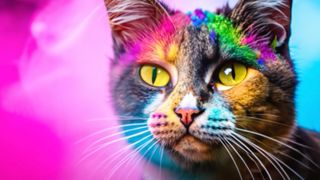Yesterday Nvidia reveal its Picasso AI is powering many generative AI models, including the newly announced Adobe Firefly, and ChatGPT now with over 100 million users and rising. Reflecting on this Nvidia's CEO Jensen Huang used his GTC keynote to call 2023 the “iPhone moment of AI”. There really is no going back now.
The staggering rise in use makes ChatGPT the fastest-growing app in history, going from a weird little-known piece of program to mainstream success almost instantaneously. This has, of course, had repercussions, with ChatGPT used to make a tourism ad from famous AI paintings and other AI have been used to create scarily real deepfakes.
But Huang is clear ChatGPT and other AI models are going nowhere and his comment we're in the 'iPhone moment' for AI image generators really puts things into perspective. The genie is out of the bottle and is making text-prompted wishes come true – and some of the biggest brands in art and design are involved.

The Nvidia DGX supercomputers, the same range delivered to OpenAI back in 2016, are now embedded in most industries and are running 24/7. Huang detailed in his GTC keynote how half of all Fortune 100 companies have installed DGX AI supercomputers, saying "DGX supercomputers are modern AI factories".
So there's no going back, but the future of AI art generators can be a safer and more responsible way than many feared. Nvidia has three eye-catching partners that are making use of its AI Foundations family of cloud services, with the standout for creatives being the Nvidia Picasso AI model and its uses.
Picasso is a text-to-image and text-to-video AI service that can be built upon by other developers and brands. Crucially this is trained on licensed content and not scraped from the web. Let's take a look at the three main uses.

Shutterstock AI used on Creative Flow
The stock footage and image library will use Nvidia Picasso to train a generative text-to-3D AI to create 3D models. This will be integrated into its Creative Flow (opens in new tab) platform. The AI will be trained using Shutterstock's assets and will turn text into 3D models that can be used in video, games and more.
This will aim to deliver 3D assets at speed for creators and designers who need to render large environments for backgrounds. Imagine working on a shot and deciding you need a car in the scene, the Shutterstock AI will add it in from a text prompt. Such text-to-3D will also be used on Turbosquid (opens in new tab), the asset site for animators and video game developers.
Shutterstock and Nvidia are at great lengths to state the AI will only use image references owned by the company, and those who create assets using the AI on Shutterstock will earn royalties.
Greg Estes, Nvidia vice president of developer programs, explained that AI "will give developers a tool that can automate much of the tedious work for artists, freeing them to spend more time exploring new concepts and refining their ideas."
Adobe launches its AI called Firefly
Adobe has announced it's teaming up with Nvidia to create a next-generation AI called Adobe Firefly, and it could be the future of AI art. Coming to Photoshop, After Effects and Premiere Pro the new generative AI platform will be used to speed up workflow.
Like Shutterstock, Adobe is keen to stress there is 'content transparency' and content credentials will be registered and tracked. The AI can be used to create images and image effects for commercial use, to improve speed and scale of projects. Visit the Adobe Firefly blog (opens in new tab) and learn more.
Getty Images
Content marketplace Getty Images will offer text-to-image and text-to-video training on a 'responsible' AI. Users will be able to create images and videos trained on Getty Images' fully licensed stock library of assets.
Again, an ethical use of AI assets and the creation of generative AI art and video is being emphasised by Getty Images and Nvidia. Any artists' work hosted on Getty Images that is used to train the AI will receive royalties, but what these amount to has yet to be revealed.
Clearly there's no escaping AI generative art and video; not only is Nvidia powering the most prominent uses currently in circulation but when the largest design brands get on board you know it's here to stay.
It's telling how eager these companies are to ensure this new generation of AI image creation is being developed with transparency, ethical uses and artist royalties in mind. Time will tell how this pans out. There's an argument for using AI to speed up a creative workflow but how far this should go is debatable, and it certainly shouldn't be at the expense of original creativity.
Fundamentally we're on the cusp of a creative explosion as the metaverse takes off in the coming years; this 3D connected universe of websites will need more assets and art than ever before, so artists may find they need to make use of AI to keep up. It's going to be an interesting era of AI generative art, and one fraught with pitfalls. All eyes are on the likes of Nvidia, Adobe and Shutterstock to make it work in an ethical way that protects creatives.
Read more:
- The weirdest AI art yet created using DALL·E 2
- AI house party images are freaking people out
- This new AI image reader is frighteningly clever


